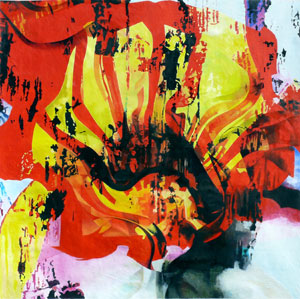The Persistence of the Real – Hungarian painter who lives in NY

Does a work of art have a cognitive element? Many will respond with a resounding “yes,” equating aesthetic value and the skilled infusion of constructive materials with an intellectual principle. The alternative is a mindless pattern of craft, a jingle in lieu of a symphony, a gymnast’s split in place of a dancer’s arabesque, Language and philosophy said.
The most careful of observers, though, can fall short when describing the nature of the mental imperative.
Can we identify its presence, for example, in the oil paintings of György Madarász?
Here a riot of color and shape at once recalls the elusive idealism of abstract expressionism. A closer look, though, often reveals the remnants of a recognizable image that suggests how the artist’s mental activity manifests in a completed work.
 Madarász begins each oil painting by imposing upon a natural object an act of intense concentration. “I envy artists who can start from nothing and put together something new,” he says. “But even if my finished work is very close to abstraction, I find I need to start with some real object.” This position recalls that of Picasso and Matisse, two artists who bucked the growing hegemony of pure abstraction a century ago by insisting on an engagement with some manifestation of the real world, if not as recognizable shape in the finished work then as foundational inspiration. Here is Picasso weighing in:
Madarász begins each oil painting by imposing upon a natural object an act of intense concentration. “I envy artists who can start from nothing and put together something new,” he says. “But even if my finished work is very close to abstraction, I find I need to start with some real object.” This position recalls that of Picasso and Matisse, two artists who bucked the growing hegemony of pure abstraction a century ago by insisting on an engagement with some manifestation of the real world, if not as recognizable shape in the finished work then as foundational inspiration. Here is Picasso weighing in:
[button link=”https://dailynewshungary.com/tag/art/” type=”big” color=”purple” newwindow=”yes”] Read more news about HUNGARIAN ARTS[/button]
“There is no abstract art. You must always start with something. Afterward, you can remove all traces of reality. There’s no danger then, anyway, because the idea of the object will have left an indelible mark.”
Read here more HERE – languageandphilosophy.com.
Source: languageandphilosophy.com





